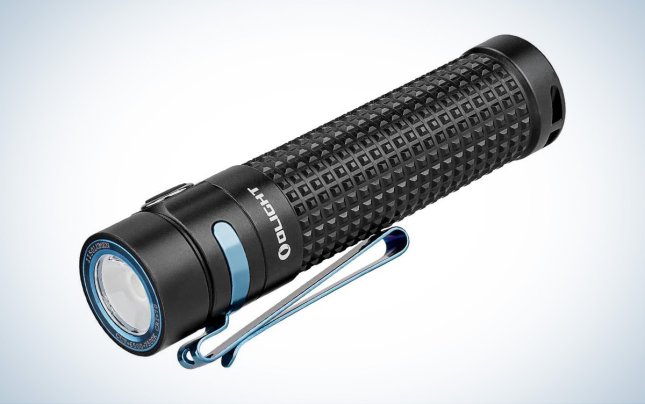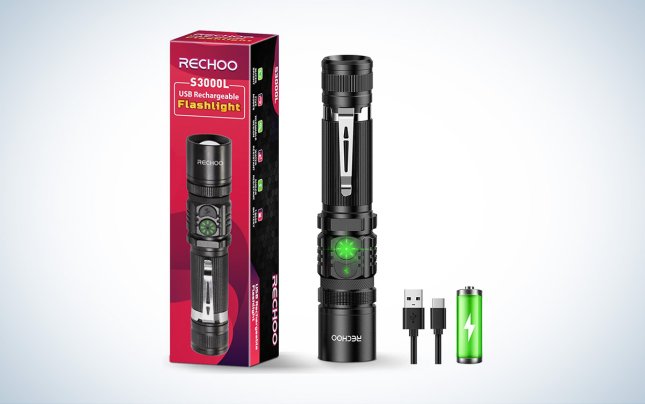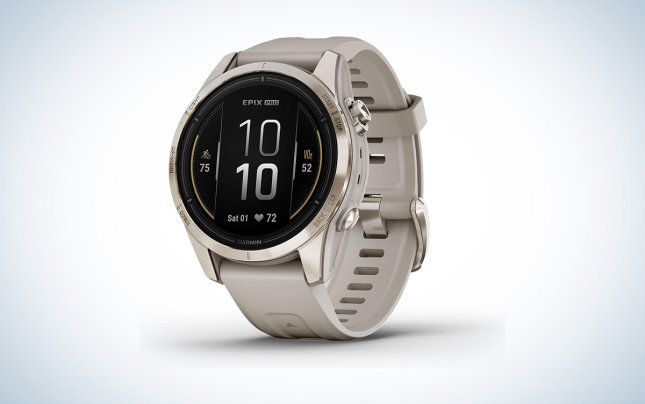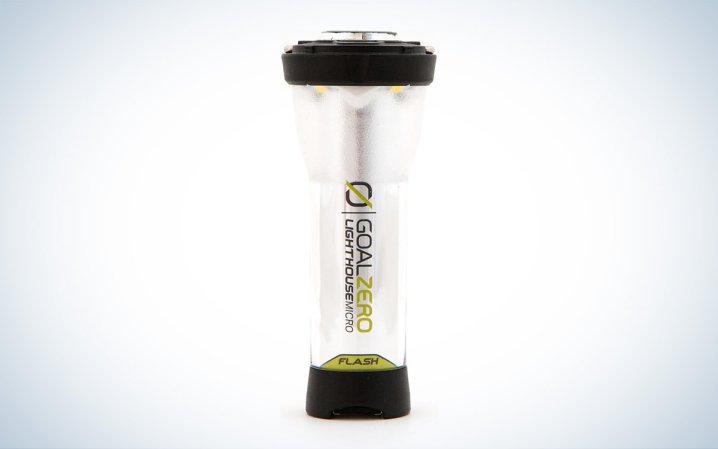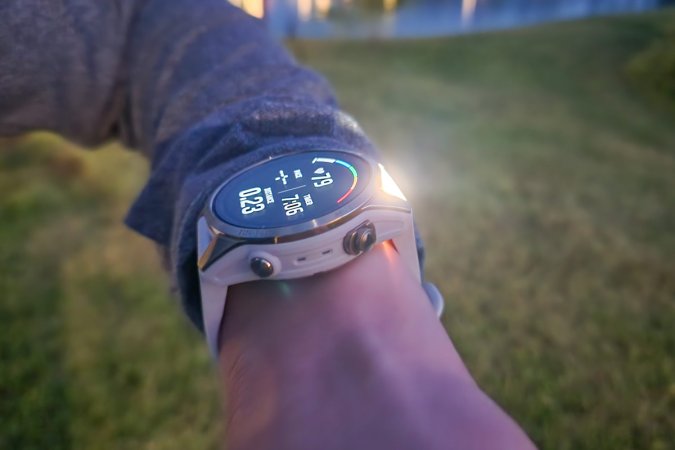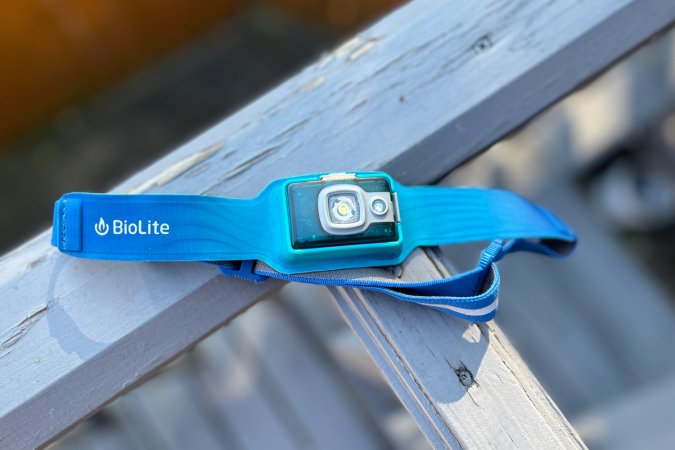We may earn revenue from the products available on this page and participate in affiliate programs. Learn more ›
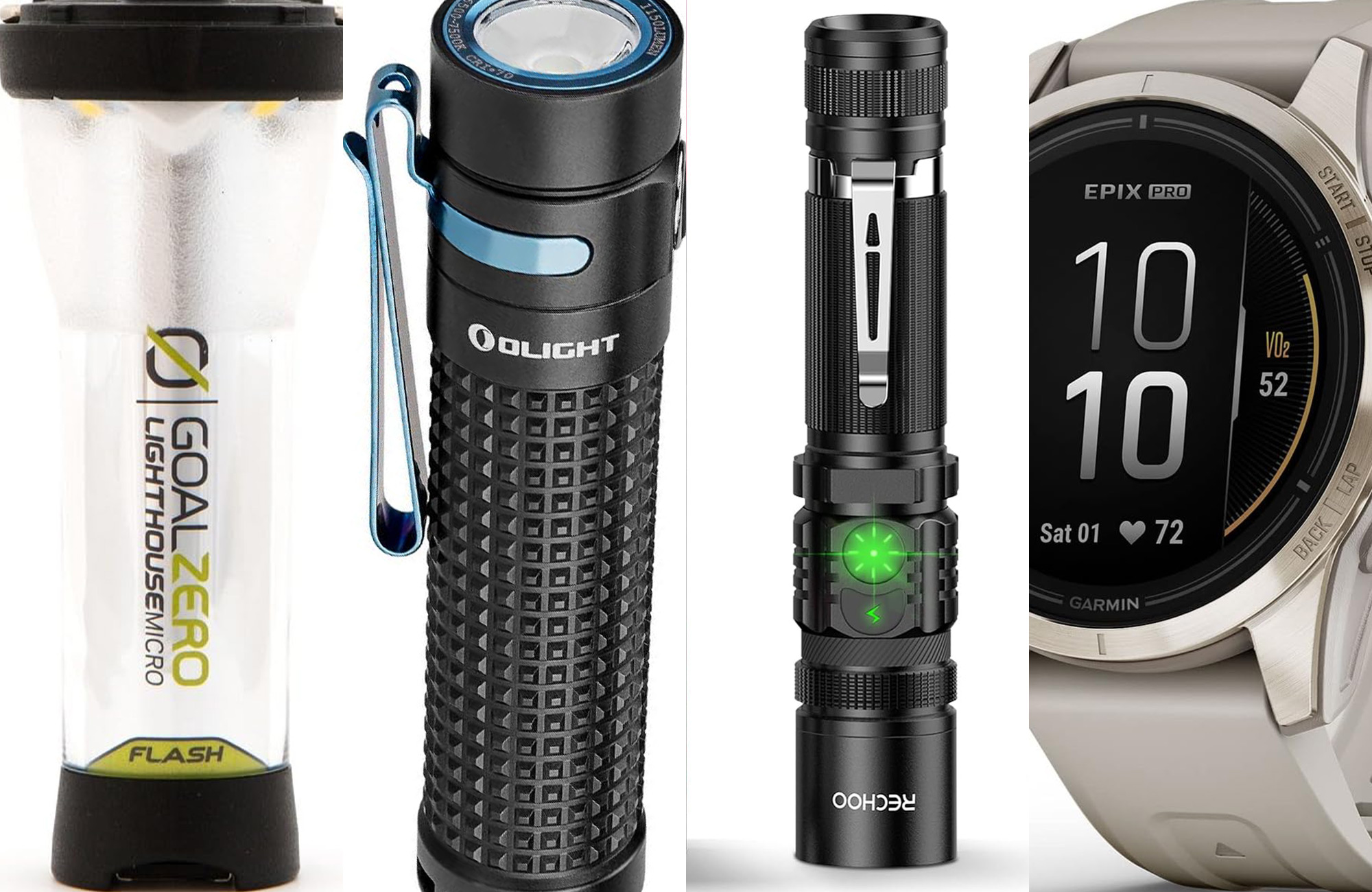
Rechargeable flashlights are extremely useful tools to keep on hand and are a great way to reduce your impact on the environment. Plus, you won’t need to make sure you have the right type of batteries on hand, saving space in your drawers. Many are even more powerful than battery-powered options. Like all flashlights, rechargeable ones come in all shapes and sizes suitable for different situations. If you’re looking to illuminate your life, the best rechargeable flashlights will be there to lend a hand.
- Best overall: OLIGHT S2R II
- Best budget: RECHOO S3000L Flashlight
- Best compact: Goal Zero Lighthouse Micro Flash
- Best watch: Garmin Epix Pro Smartwatch
- Best headlamp: BioLite HeadLamp 325
How we chose the best rechargeable flashlights
When selecting the best rechargeable flashlights included in this guide, we evaluated numerous brands and models to choose the best for a variety of situations. Brightness and battery life were two of the most important aspects of the lights we looked at, as a dim flashlight that doesn’t last very long isn’t useful to anyone. We also considered ease of charging, size, waterproofing, and durability. Finally, some flashlights offer extra features that set them apart, such as the ability to charge other devices, magnetic parts, clips, and different lighting modes. We made our decisions based on a mix of hands-on testing, editorial reviews, and user feedback.
The best rechargeable flashlights of 2023: Reviews & Recommendations
For many people, your smartphone is the only rechargeable flashlight you might think you need. But you should probably conserve phone battery if you’re in the kind of situation where you really need to use a flashlight (and you don’t want to drop that expensive phone trying to fish it out of your pocket in the dark, cracking the screen). So dedicated rechargeable flashlights are ideal for a range of needs, from filling out emergency kits, adding light on camping trips, or illuminating your car while tinkering away. The options below are sure to add light to any situation.
Best overall: OLIGHT S2R II
Best overall
OLIGHT S2R II
Pros
- Features a magnetic base and clip
- Six lighting modes
- Provides a max throw of 443 feet
- IPX8 rated and drop tested to 4.9 feet
Cons
- Controls aren’t intuitive
- Pricey
Specs
- Lumens: 1,150 Lumens
- Charging method: Proprietary magnetic charger
- Max run time: 60 hours
- Weight: 3.4 ounces
- Dimensions: 0.91 x 0.91 x 3.94 inches
The OLIGHT S2R II earns our top spot thanks to its superb brightness, long battery life, and rugged design. It offers up to 1,150 lumens with 4,600 candelas and a maximum throw of 443 feet. It’s an intensely bright light, and because of that, the brightest setting is best used exclusively outdoors. Luckily, you can select between turbo (the brightest setting), moonlight, and strobe mode for more control over your light.
One feature that makes the S2R II stand out is the battery indicator. Not many rechargeable flashlights offer that. Green, yellow, and red lights tell you how much charge is left in the battery, so you aren’t guessing before heading out into the night. The light charges with the included MCC 1A charger, a magnetic charging system that snaps onto the end of the flashlight.
The S2R II offers six different lighting modes, including turbo, moonlight, and strobe. The dimmest setting provides a run time of 60 days, while the brightest will last for just under four hours. It’s made of a textured aluminum alloy so that it won’t slip out of your hand. And if it does happen to fall, it’s drop-tested to 4.9 feet. It also features an IPX8 rating, so it will survive even if it falls in a puddle.
Best budget: RECHOO S3000L Flashlight
Best budget
RECHOO S3000L Flashlight
Pros
- Charges via USB-C
- IP65 rated
- 5 lighting modes including a SOS mode
- Affordable
- Telescoping head to adjust the beam
Cons
- Battery life isn’t as good as others
Specs
- Lumens: 1,500 Lumens
- Charging method: USB-C
- Max run time: 10 hours
- Weight: 5.6 ounces
- Dimensions: 5.45 x 1.05 x 5.45 inches
Most rechargeable flashlights are relatively expensive, but the RECHOO S3000L offers a more affordable alternative. Despite its $15 price, it still has plenty to offer, making it a worthy choice for emergency kits or daily use. It provides up to 1,500 lumens, which is plenty of brightness for most situations. Unfortunately, RECHOO doesn’t provide a max throw or candela, but it does feature a telescoping design that allows you to adjust the beam width depending on what you need.
The S3000L offers five different lighting modes, which include three brightness levels and a one-click emergency mode. It is made of military-grade aluminum alloy and is built to be highly durable, with an IP65 rating. A clip on the side allows you to keep it secure in a pocket, and the textured metal keeps it from slipping from your hand.
One thing we really like about this light, besides its price, is that it charges via USB-C, which is what most devices use these days. That means you’ll likely always have one on hand. Unfortunately, you’ll be charging it more than other options. On the dimmest setting, it only offers around 10 hours of battery life, which is lower than other options on our list. But the price is hard to beat.
Best compact: Goal Zero Lighthouse Micro Flash
Best compact
Goal Zero Lighthouse Micro Flash
Pros
- Functions as a flashlight or lantern
- IPX6 rated
- Very compact and lightweight
- Built-in battery indicator
Cons
- Not very bright
Specs
- Lumens: 120 Lumens in flashlight mode, 150 as a lantern
- Charging method: USB
- Max run time: Up to 7 days
- Weight: 2.4 ounces
- Dimensions: 3.66 x 1.5 inches
If weight and size are key considerations for you, perhaps because you’re looking for a rechargeable flashlight for backpacking, the Goal Zero Lighthouse Micro Flash is the best option. It weighs just 2.4 ounces and is only 3.66 inches long, so it won’t take up hardly any space in your pack. It’s also IPX6-rated and built to last.
One unique feature of this Goal Zero light is that it can work as a lantern or flashlight. A ring at the top allows you to hang it from your tent or backpack when you want broad, filling light. In lantern mode, it offers up to 150 lumens. You’ll get up to 120 lumens when using it as a flashlight. There are plenty of different modes to adjust the brightness as well.
Depending on what brightness setting you use, you’ll get anywhere from 7 to 170 hours of runtime. It charges via USB and can be fully charged within 3.5 hours. Should you need more battery life when in the backcountry, you can pick up the Nomad 5 solar panel, which will provide the same charge time as plugging into the wall if you have enough sun (and Goal Zero makes some of our favorite solar generators, so you can trust it works). Should you want a similar light that can also charge other devices, the Lighthouse Micro Charge offers the same light features but with the additional feature of serving as a battery pack.
Best watch: Garmin epix Pro (Gen 2) Smartwatch
Best watch
Garmin Epix Pro (Gen 2) Smartwatch
Pros
- Available in three sizes and three colors
- Excellent battery life
- Bright, colorful display
- Battery life offers variable intensity, a strobe mode, and red safety light
- Lots of performance and health tools
Cons
- Expensive
Specs
- Lumens: 200 Lumens
- Charging method: Proprietary charger
- Max run time: Up to 16 days
- Weight: 2.22 ounces (42mm version)
- Dimensions: 1.65 x 1.65 x 0.56 inches (42mm version)
It may seem odd to include a watch in a list of the best rechargeable flashlights. But this Garmin smartwatch features a built-in LED flashlight that is extremely useful. The light is built into the bezel of the watch on the top end so that it naturally points in a useful direction without needing to contort your wrist awkwardly. A quick double tap of a button turns it on, and you can select between four different intensity levels, a red mode, and a strobe function.
I find myself using the flashlight on my epix Pro on a nearly daily basis. It’s perfect for early morning walks in the dark with my dog or trying to find things in the back of dark cabinets. At 200 lumens, it is surprisingly bright for how little it is, easily illuminating what I need.
Beyond the flashlight, the epix Pro is an incredibly capable fitness watch. It features a long list of sensors to track and calculate a variety of health and performance metrics, including heart rate, sleep, VO2 max, and much more. It can even act as an ECG to detect irregular heart rhythms. The built-in adaptive training tools can help you keep your fitness progressing. You’ll have access to detailed maps with topographic information, weather overlays, and plenty of navigation tools. And it’s built to military standards for thermal, shock, and water resistance. If you want a flashlight that is so much more and can keep your hands free, the Garmin epix Pro is hard to ignore.
Best headlamp: BioLite HeadLamp 325
best headlamp
BioLite HeadLamp 325
Pros
- Lightweight
- Sits flat and is stable on the head
- Charges via microUSB
- Material is moisture-wicking
Cons
- Hard to open the charger
Specs
- Lumens: 325 Lumen
- Candela: Not provided
- Charging method: microUSB
- Max run time: 40 hours
- Weight: 1.7 ounces
- Dimensions: 2.05 x 1.97 x 8.27 inches
If bulky, heavy headlamps make night hikes a headache, consider the BioLite HeadLamp 325, a lightweight light in the dark. It only weighs 1.7 ounces, and it doesn’t bounce around while running or doing a cartwheel. The headlamp charges via microUSB—an incredibly common charger you most likely already have around the house. A rear reflective strip alerts those behind you that you’re there, and an articulating front bezel allows you to angle the light where you need it with just one hand.
We recently took it on a trip to Arizona and were pleased with how its moisture-wicking fabric kept our forehead comfortable during nighttime jaunts to the bathroom or campfire. Plus, it laid flat to our heads—something we can’t say with other headlamps we’ve tried.
We named its beefier cousin, the BioLite HeadLamp 800 Pro, as the best headlamp for hiking. If you’re more of a casual wanderer or just need something to illuminate the way to take out the trash, the HeadLamp 325 packs a powerful, portable punch.
Things to consider when buying rechargeable flashlights
Rechargeable flashlights aren’t typically fancy pieces of equipment with endless options in regard to features. But different situations may call for a different type of light than others. Below are some of the most important things to look out for when choosing a rechargeable flashlight.
Lumens & candela
A flashlight doesn’t do much good if it doesn’t illuminate well. But you don’t always need the face of the sun in your hand, either. There are a few different factors that impact how bright a flashlight appears: Lumens and candela.
Lumens is likely a familiar term to most. The number of lumens a rechargeable flashlight has tells you the amount of light it produces. Broadly speaking, the more lumens, the brighter the light. However, this measurement is taken at the very front of the light source, so it doesn’t give you any indication of how far it shines or how wide of an area it covers.
That’s where candelas come in. Candela refers to how focused and intense the light from a flashlight is. Candela measurements get a bit complicated, but put simply, a large candela number means the beam will be more focused, which is ideal for when you need to illuminate things in the distance. A low candela number refers to a broad beam of light, which is better for when you need light up close.
Not many companies list candelas, but they may provide a beam distance measurement instead.
Size & weight
Rechargeable flashlights come in a range of shapes and sizes and thus weights. What you need a flashlight for will determine what size is best. For example, a large, heavy flashlight is fine for in your home in case the power goes out. But you won’t want to take that backpacking with you or hold it while working on your car. Size is more important for certain applications than others, but be sure to check the weight and dimensions prior to hitting that buy button.
Light modes
Some rechargeable flashlights will offer various light modes and even different intensity levels. Dimming adds to the versatility of a torch since you’ll be able to adjust the brightness depending on the conditions. If you will be using your light when camping, in an emergency kit, or in similar situations, a strobe light or SOS setting may be valuable to have. If that’s the case, look closely at what light modes are available in the models you are considering.
Battery life & charging
As with any electronic device, rechargeable flashlights will offer various levels of battery life. If you need a flashlight for emergency situations or when roughing it in the outdoors, long battery life is incredibly important. However, if you have access to a charger and know you’ll only need the light for short periods, a short battery life may be okay.
Also worth considering is how you’ll charge your light. Some feature built-in USB ports that are easy to access. Others use rechargeable batteries that you will have to take out and charge with an adapter. Which is best is largely a matter of preference, though charging via a port is typically more convenient.
Additional features
Beyond the basics listed above, there are a handful of additional things to look out for when choosing a rechargeable flashlight. Waterproofing or IPX ratings may be essential if you need to use the light on a boat or in a hurricane preparedness box. A clip, magnet, or strap could be crucial if you are trying to use it hands-free. Some lights can also act as a battery for other devices, which is ideal for camping or emergency situations.
FAQs
Each situation will differ in terms of how many lumens are necessary. A light with 1,500 lumens will be way too much for use in a small interior space, while 100 lumens won’t be nearly enough to illuminate a forest. Broadly speaking, 200 lumens is ideal for small, compact lights. If you need more brightness, look for something with at least 1,000 lumens or more.
Yes, you can use rechargeable batteries in flashlights. In fact, that can be a great way to turn the flashlight you likely already have into a rechargeable flashlight without purchasing an entirely new light.
The price of rechargeable flashlights depends on the light’s brightness, size, battery life, and any additional features it may offer. You can find lights as cheap as $15 or up to $150, depending on what you need.
Final thoughts on the best rechargeable flashlights
- Best overall: OLIGHT S2R II
- Best budget: RECHOO S3000L Flashlight
- Best compact: Goal Zero Lighthouse Micro Flash
- Best watch: Garmin Epix Pro Smartwatch
- Best headlamp: BioLite HeadLamp 325
Rechargeable flashlights are becoming more and more common, with options constantly expanding. What flashlight is best for you depends on how you intend to use it and your specific needs. Paying attention to a light’s brightness, throw distance, durability, battery life, and charging options will help you choose an option that best illuminates your life.
